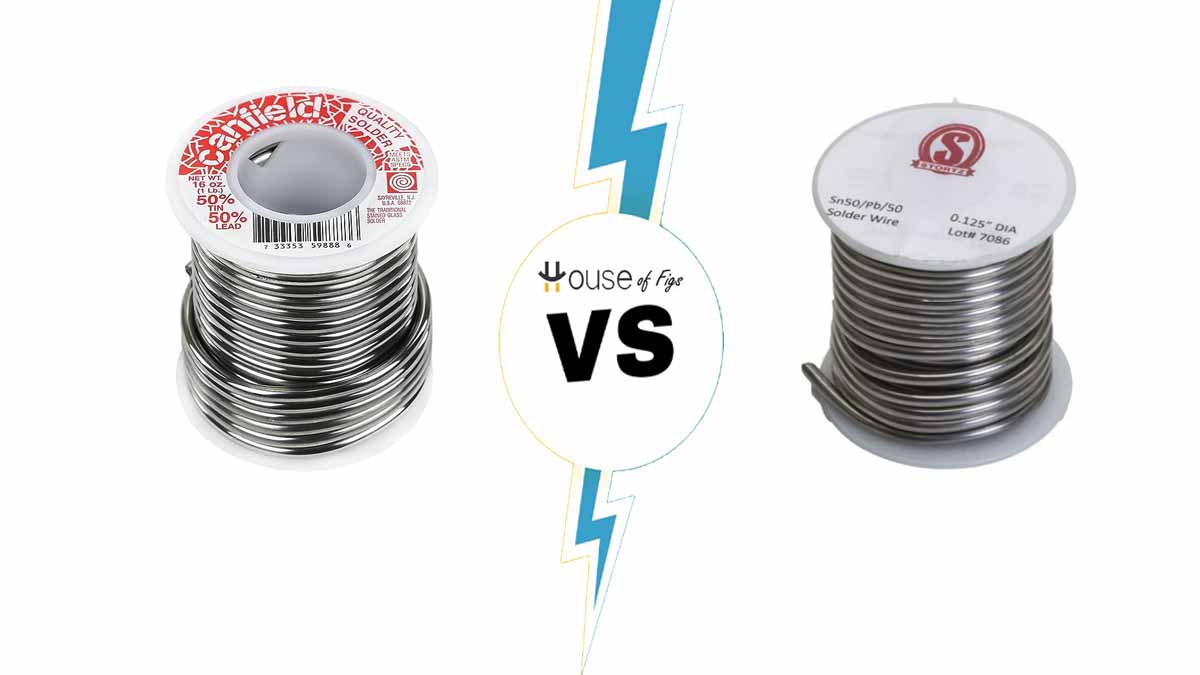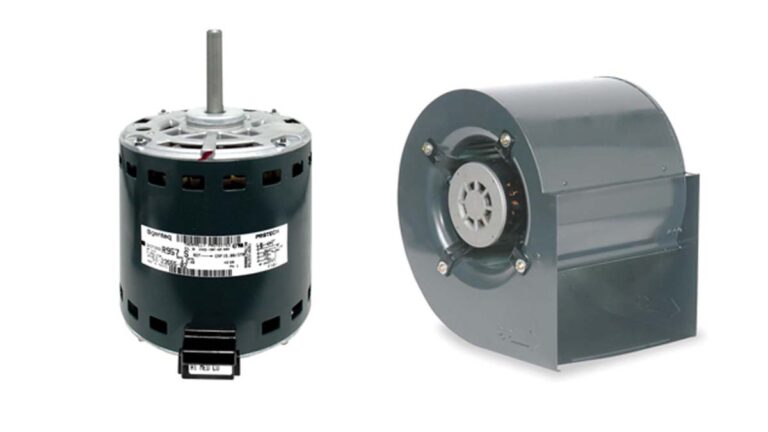95/5 Solder Vs. 50/50 Tin/Lead Solder – A Detailed Comparison, Pros & Cons
When it comes to soldering, choosing the right material is essential. Today, we are focusing on 95/5 solder and 50/50 Tin/Lead solder. Each of these materials comes with its own set of characteristics that makes it suitable for different soldering projects. So, it’s vital to understand the core differences to make an informed decision. Now, let’s focus on a straightforward comparison between these two types of solder, followed by a detailed discussion.
95/5 Solder Vs. 50/50 Tin/Lead Solder: Quick Comparison
| Feature | 95/5 Solder | 50/50 Tin/Lead Solder |
|---|---|---|
| Composition | 95% Tin, 5% Antimony | 50% Tin, 50% Lead |
| Melting Point | Higher (~450°F) | Lower (~361°F) |
| Flow Rate | Slower | Faster |
| Strength | Stronger | Weaker |
| Toxicity | Less Toxic | More Toxic |
| Price | More Expensive | Less Expensive |
| Ideal Use | Plumbing, Food Industry | General Soldering |
What Are The Key Differences Between 95/5 Solder Vs. 50/50 Tin/Lead Solder?
Assessing Composition and Performance
95/5 solder is primarily composed of 95% tin and 5% antimony. This composition leads to a solder with a higher melting point, usually around 450°F. This characteristic makes it a reliable choice for jobs that demand a stronger bond. On the other hand, 50/50 Tin/Lead solder contains an equal percentage of tin and lead, contributing to its lower melting point of 361°F. This lower melting point allows for a faster flow rate, which can be advantageous in many general soldering tasks.
Examining Toxicity and Environmental Impact
With growing environmental concerns, the toxicity level of soldering materials has become a crucial factor. 95/5 solder stands out as a less toxic option due to its lead-free composition, which is especially important in industries like plumbing and food service. Conversely, the lead content in 50/50 Tin/Lead solder makes it more toxic and less environmentally friendly.
Cost Factors
Budget considerations are often as important as performance. Here, 50/50 Tin/Lead solder shines as a more budget-friendly option compared to 95/5 solder. Its lesser cost makes it a go-to option for hobbyists and those undertaking general soldering projects.
Determining Ideal Use Cases
Different tasks call for different materials. The stronger bond and less toxic nature of 95/5 solder make it a preferable choice for plumbing projects and applications within the food industry. On the flip side, 50/50 Tin/Lead solder is often chosen for general soldering tasks due to its good flow rate and lower cost.
Key Takeaways
- 95/5 solder and 50/50 Tin/Lead solder have distinctive compositions leading to different melting points and flow rates.
- 95/5 solder is less toxic and more environmentally friendly, making it suitable for plumbing and food industry applications.
- 50/50 Tin/Lead solder is more cost-effective, making it a preferred choice for general soldering projects.
- The right solder for your project largely depends on the specific requirements of the task at hand.
Pros and Cons
When embarking on a soldering project, having the right material is a step in the direction of success. 95/5 solder and 50/50 Tin/Lead solder are popular choices, each having its merits and demerits.
Pros of 95/5 Solder
Embracing Environmental Responsibility
95/5 solder is a lead-free solder option, which is not only safer for the user but also better for the environment. This eco-friendly aspect is particularly crucial in the current times when environmental conservation is a priority.
Seizing Strength
With a composition of 95% tin and 5% antimony, 95/5 solder exhibits a higher level of strength compared to its 50/50 counterpart. This characteristic is essential in creating durable joints, ensuring the longevity of the soldered items.
Experiencing Less Toxicity
Due to the absence of lead, 95/5 solder is less toxic. This reduced toxicity is a vital factor, especially in industries like plumbing and food service where human health and safety are paramount.
Cons of 95/5 Solder
Facing Higher Costs
The environmental and health benefits of 95/5 solder come at a higher price. Its cost might be a hurdle for hobbyists or individuals working on a tight budget.
Enduring Slower Flow
The higher melting point of 95/5 solder results in a slower flow rate, which might not be ideal in scenarios where quick soldering is necessary.
Pros of 50/50 Tin/Lead Solder
Enjoying Cost Efficiency
One of the notable advantages of 50/50 Tin/Lead solder is its affordability. It’s a cost-effective option that appeals to many, especially those working on smaller projects or with budget constraints.
Benefiting from Lower Melting Point
With a lower melting point, 50/50 Tin/Lead solder flows faster, making the soldering process quicker and more straightforward, which is particularly useful in general soldering tasks.
Cons of 50/50 Tin/Lead Solder
Contending with Toxicity
The presence of lead in 50/50 Tin/Lead solder makes it toxic, posing health risks to the user and the environment. This factor is a significant downside, especially in long-term or frequent usage.
Compromising on Strength
The equal composition of tin and lead results in a weaker bond compared to 95/5 solder, which could be a determining factor depending on the nature of the project.
95/5 Solder Vs. 50/50 Tin/Lead Solder – Which Should You Choose?
Choosing between 95/5 solder and 50/50 Tin/Lead solder boils down to the specific needs of your project. If environmental concerns, strength, and less toxicity are your priorities, 95/5 solder is a solid choice.
However, if you’re looking for a cost-effective solution and working on general soldering tasks, 50/50 Tin/Lead solder might serve you well.
Conclusion: 95/5 Solder Vs. 50/50 Tin/Lead Solder
- 95/5 Solder is a lead-free, environmentally friendly option, ideal for industries like plumbing and food services due to its less toxic nature and stronger bond.
- 50/50 Tin/Lead Solder is more budget-friendly, with a faster flow rate due to its lower melting point, making it suitable for general soldering tasks.
- The decision between the two largely depends on the specific requirements of the project, cost considerations, and environmental or health concerns.
Frequently Asked Questions (FAQs)
Is 95/5 solder lead-free and what is it commonly used for?
Yes, 95/5 solder is lead-free, making it a safer and more environmentally friendly option. It’s commonly used in plumbing and food service industries where a stronger bond and less toxicity are crucial.
When should 95/5 solder be used, especially concerning copper materials?
95/5 solder should be used when a stronger bond is required, or when working with potable water systems or food service applications. It’s also well-suited for soldering copper materials due to its strong bonding capability.
What distinguishes 95/5 solder from 50/50 Tin/Lead solder in a copper-based project?
95/5 solder, being lead-free and having a strong bonding capacity, is often preferred in copper-based projects, especially in plumbing and similar industries where a durable bond is essential.
What are the main takeaways from comparing 95/5 solder vs 50/50 Tin/Lead solder?
On this comparison typically highlight the lead-free nature and stronger bonding capability of 95/5 solder against the cost-effectiveness and faster flow rate of 50/50 Tin/Lead solder.
How does 95/5 solder compare to silver solder, and which one is better?
95/5 solder and silver solder differ in their composition and melting points. Silver solder, with a higher melting point, provides a stronger bond, making it suitable for high-temperature applications. The choice between them depends on the project requirements concerning strength, temperature, and budget.
Which solder is considered best for soldering, especially regarding the solder ratio?
The best solder for soldering largely depends on the task at hand. A good solder ratio like 60/40 (tin/lead) is often recommended for electronic works due to its lower melting point and good flow. However, for plumbing, a lead-free solder like 95/5 is preferred.
Is lead-free solder like 95/5 generally better and safer?
Lead-free solder like 95/5 is better in terms of environmental impact and safety as it reduces exposure to toxic lead. It’s a better choice for applications involving potable water or food service.
What’s the general consensus regarding the safety and effectiveness of 95/5 solder?
95/5 solder is considered safe and effective, especially in industries where avoiding toxic materials is crucial. Its strong bonding capacity also makes it a reliable choice for various applications.
Is 95/5 solder good for copper and is it the best option?
95/5 solder works well with copper, especially in plumbing applications. However, whether it’s the best option depends on the specific project requirements, including budget and environmental considerations.


